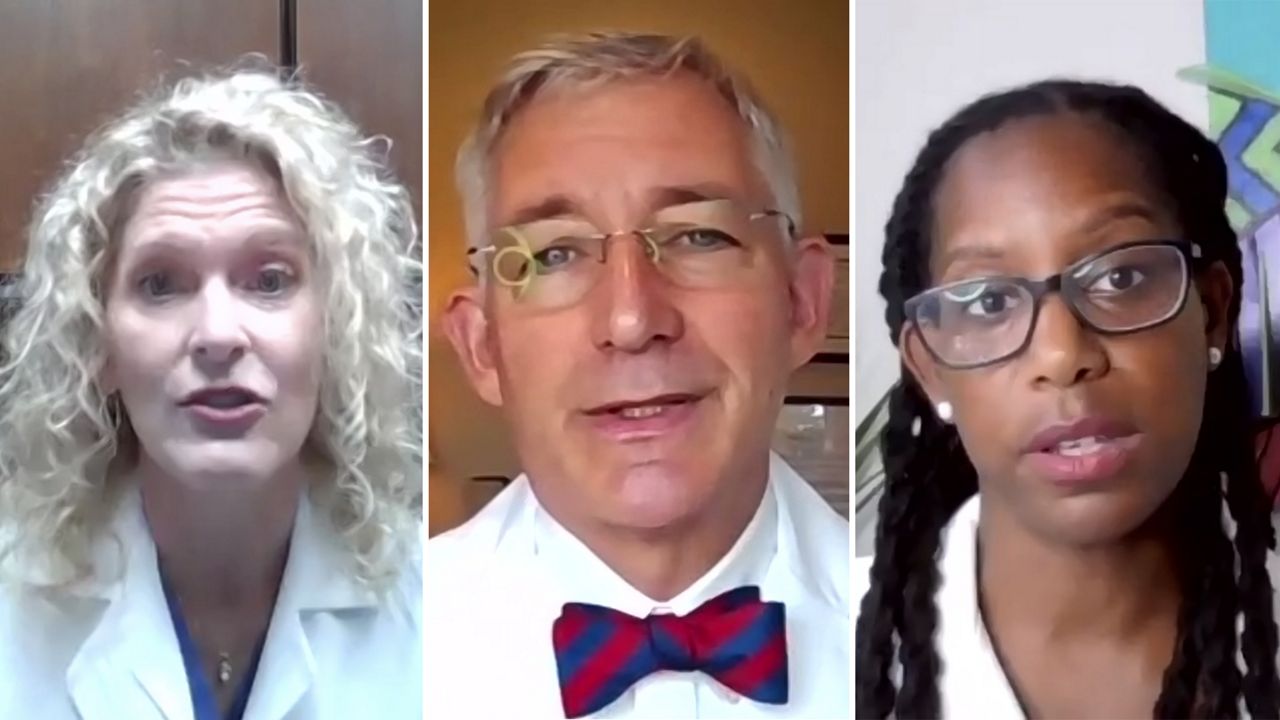COLUMBUS, Ohio — While the spread of COVID-19 in Ohio is beginning to slow down, cases “remain extremely high," presenting continued risk for unvaccinated residents, Ohio Health Director Dr. Bruce Vanderhoff said Monday.
What You Need To Know
- COVID-19 cases are peaking, but virus spread remains high, Vanderhoff said
- Doctors addressed concerns among pregnant women in Ohio about getting vaccinated
- The Ohio Department of Health began reporting third-shot numbers on Monday
With the high levels of COVID-19 in the state, pregnant women are at particularly high risk due to their increased chance for severe illness and the low rates of vaccination in the demographic, experts at an Ohio Department of Health news conference explained Monday.
Vanderhoff said he sees a "little ray of sunshine" in the latest COVID-19 numbers, with signs that Ohio's COVID-19 cases are finally cresting. As of Sunday's update, seven-day average cases were at 5,676, a 22% decline from a recent high of 7,268 on Sept. 16.
“Thankfully, we are seeing early indicators that cases appear to be peaking and beginning to point toward a decline. I'd expect that hospitalizations and deaths should soon follow,” Vanderhoff said. “I know it has been a very long journey. We're all tired of dealing with COVID-19, but I'd ask everyone to hang in there.”
He said in Thursday's update he expects to see the statewide COVID-19 case rate make a week-to-week decline for the first time since the latest surge began. The metric, which is considered the most important case number by state officials, is based on a two-week reporting period.
Vanderhoff was joined by Dr. Kamilah Dixon-Shambley, assistant professor of OB-Gyn at Ohio State Wexner and Dr. Lisa Egbert, an obstetrician/gynecologist with Paragon Women's Care.
The doctors responded to the Centers for Disease Control and Prevention’s Wednesday health advisory that urged pregnant women to get vaccinated. The agency said August was a record month for COVID-19 related deaths among pregnant patients. The CDC shared data showing that pregnant women are at 70% increased risk of death.
“Generally, my patients are young and healthy,” said Dixon-Shambley. “But because of the physiology of pregnancy, that puts you at an increased risk for severe disease from COVID-19, so you are now in a high-risk category whereas previously you may not have been.”
Egbert said she understands the “mama bear” instinct for a woman to protect her unborn child from anything unknown, but she said the science is very clear that vaccination is safe for pregnant women and their babies. She agreed that the low-vaccination rate among pregnant women in the U.S. of 31% is a great concern.
“Delta is so much more infectious, and it's taking out our young healthy pregnant women, so I tell them, 'Look, we don't want you or your husband to be in a position where you have to decide, is my life at risk? Is there risk for my baby?' Imagine what it's like for that young dad when he has to risk delivering a pre-term baby to save his wife, and even then, he still may lose either his wife or his baby, or even worse both, and sadly we've seen it right here in our ICUs in Ohio.”
During the press conference, Vanderhoff provided updates about several other COVID-19 matters, including booster shots, therapeutic treatments and dashboard reporting changes.
Vanderhoff said Ohio will report the number of third vaccine doses administered on the state’s COVID-19 vaccination dashboard beginning Monday afternoon.
Federal officials said Monday that the vaccine booster program in the U.S. is off to a “very strong start,” with nearly 2 million people getting a third Pfizer-BioNTech shot during the first week of the limited rollout.
The Food and Drug Administration (FDA) announced Friday that its vaccine committee meets on Oct. 14 and Oct. 15 to discuss authorizations for booster doses of the Moderna and Johnson & Johnson COVID-19 vaccines.
Vanderhoff said Monday that Ohio is making one other COVID-19 dashboard change, launching a new data tracking tool that will show how many school-aged Ohioans 12-17 have been immunized.
To date, the state has reported the vaccination rate for children aged 0-19, which is 18.2%, but that age group included those who were not old enough to be eligible for a vaccine.
Hospitals and health care providers in Ohio are giving more high-risk COVID-19 patients monoclonal antibody treatments, Vanderhoff said.
“In recent months, utilization of monoclonal antibodies has increased significantly in Ohio with thousands of doses weekly now being administered,” he said.
But the distribution process recently suffered a setback, he said. In August, the federal government adjusted the process for distributing the therapeutics, putting state governments in charge of equitably distributing the treatments to providers. Under the old system, providers ordered directly from the wholesaler.
“This fairly sudden change by the federal government caused a significant disruption to the states and providers, largely because it was unexpected,” Vanderhoff said. “Hospitals, pharmacies, long-term care settings and other providers weren't aware of the change until they found themselves not receiving orders they were expecting.”
Vanderhoff said the Ohio Department of Health quickly responded to the disruption, working with the Ohio Hospital Association and the Ohio Department of Aging to best distribute the drugs to where they are needed.
Ohio’s COVID-19 case reporting has begun counting reinfection cases for individuals who contract the virus a second time if it's at least 90 days after the first infection, Vanderhoff said. He said the change follows the release of new case definitions in the Council of State and Territorial Epidemiologists’ latest annual update.
“In alignment with national guidance, the Ohio Department of Health will be counting any individuals reinfected from COVID-19 from Sept. 1 on as a new case,” Vanderhoff said. “This updated definition provides better insight into the real spread of COVID-19 across our communities.”
Vanderhoff said that in regard to the subject of reinfection, emerging data shows that unvaccinated people are at double the risk compared to fully vaccinated individuals.



